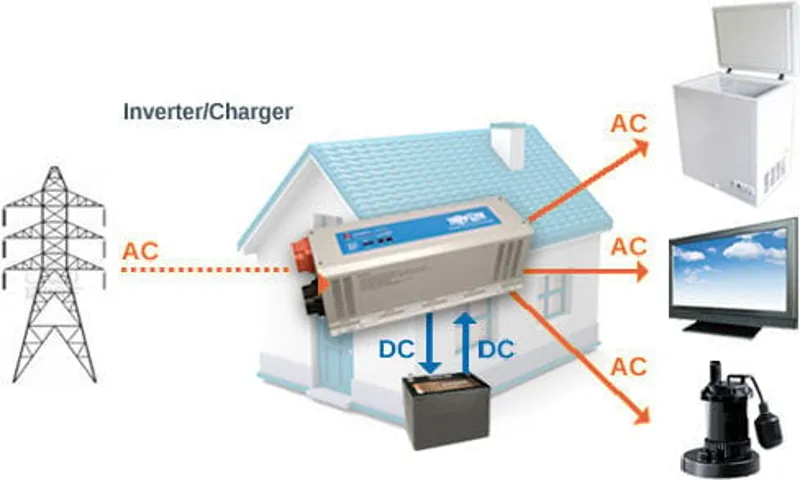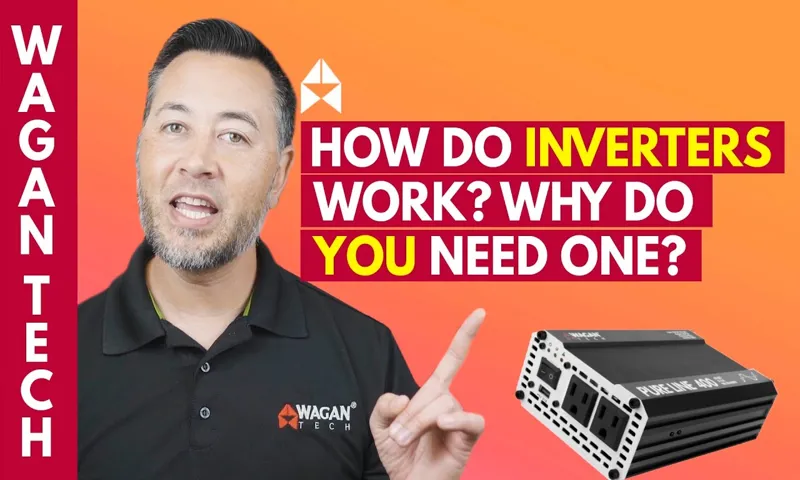Hey there! Have you ever wondered how to keep your electronic devices running even when you’re nowhere near an outlet? Well, that’s where a power inverter comes in handy. What is a power inverter, you ask? Think of it as a magician that transforms direct current (DC) into alternating current (AC), allowing you to power up your gadgets using your car’s battery or a portable generator. It’s like having your own portable power source on the go! Let’s break it down a bit.
You see, most of our household appliances and electronic devices, like laptops, smartphones, and even refrigerators, run on AC power. But when you’re out and about, you generally only have access to DC power, like the one stored in a car battery. That’s where the power inverter swoops in to save the day.
Picture this: you’re on a road trip, and your phone’s battery is about to die. With a power inverter, you can simply plug your phone charger into it, connect it to your car’s battery, and voila! Your phone is charging as if it were plugged into a wall outlet. It’s like having a portable charging station right in your vehicle.
But power inverters aren’t just useful for road trips. They can also come in handy in emergency situations. Imagine a power outage due to a storm or other unforeseen circumstances.
With a power inverter and a portable generator, you can power up essential appliances, keeping your food from spoiling and your family safe and comfortable. Now, you may be thinking, “Can’t I just use a car charger for my devices?” Well, while a car charger is great for charging your devices while driving, it’s not as versatile as a power inverter. A power inverter allows you to charge larger devices, like laptops, or use appliances that require AC power.
So, the next time you find yourself in need of power on the go or during an unexpected power outage, remember the power inverter. It’s a small yet mighty device that brings convenience and peace of mind in a world increasingly reliant on technology.
Table of Contents
How Does a Power Inverter Work?
Have you ever wondered how a power inverter works and what exactly it does? Well, let me break it down for you. A power inverter is a device that converts DC (direct current) power into AC (alternating current) power. It allows you to use your electronic devices and appliances that require AC power, such as laptops, televisions, and refrigerators, from a DC power source, such as a car battery or a solar panel.
Think of it as a translator between the different languages of power. Just like how you might need a translator to communicate with someone who speaks a different language, the power inverter acts as a mediator between the DC and AC power systems. It takes the energy stored in the battery or solar panel and converts it into the appropriate voltage and frequency to power your devices.
So, the next time you’re on a road trip and want to charge your phone or watch a movie on your laptop, you can thank the power inverter for making it possible!
Conversion Process
power inverter

Types of Power Inverters
power inverter, power source, DC to AC, electrical devices, car battery, electrical system, electrical grid, backup power, alternating current. A power inverter is a device that converts direct current (DC) power from a power source, such as a car battery, into alternating current (AC) power that can be used to power electrical devices. It works by taking the DC power and converting it into a high-frequency AC power, which is then stepped up to the desired voltage level.
This AC power is then fed into the electrical system of the device, allowing it to operate as if it were connected to a standard electrical grid. Power inverters are very useful in situations where AC power is not readily available, such as when camping or during a power outage. They also come in handy for powering appliances in a car, boat, or RV.
So, the next time you need backup power for your electrical devices, consider using a power inverter to convert your DC power into AC power.
Common Uses of Power Inverters
So you’re wondering, what exactly does a power inverter do? Well, it’s actually quite a useful device. A power inverter is designed to convert the DC (direct current) power from your car’s battery into AC (alternating current) power. But why would you need to convert the power? Well, the AC power is what is used by most household appliances and electronics.
So, if you ever find yourself on a road trip and you want to power your laptop or charge your phone, a power inverter can come in handy. But that’s not all it can do. Power inverters are also commonly used in camping trips or during power outages, providing you with electricity to run small appliances or even power tools.
They can be a true lifesaver in these situations. So, the next time you find yourself in need of some AC power on the go, just remember, a power inverter has got you covered!
Powering Household Appliances
“Powering Household Appliances” Power inverters are incredibly useful devices that allow us to power our household appliances and electronics even when we don’t have access to traditional electrical outlets. So what exactly are the common uses of power inverters? Well, one of the most common uses is when we’re on the go, and we want to use our electronics in our cars or boats. With a power inverter, we can plug in our laptops, smartphones, and even small appliances like a mini-fridge and have them run on the power from our vehicle’s battery.
This is especially handy when we’re on a road trip and need to charge our devices or keep our snacks cool. But power inverters aren’t just limited to being used in vehicles. They can also be very helpful during power outages.
Imagine being in the middle of a storm and losing power. With a power inverter, you can connect it to your car’s battery and power essential appliances in your home, like a refrigerator or a medical device. This can be a lifesaver in emergency situations.
Another common use of power inverters is for outdoor activities, such as camping or tailgating. Instead of relying on a generator, which can be noisy and require fuel, a power inverter allows you to connect your appliances directly to your car’s battery. This means you can have access to electricity while enjoying the great outdoors.
So whether you need to power a grill, a blender for margaritas, or even a television for watching the game, a power inverter can make it possible. In conclusion, power inverters have a wide range of uses when it comes to powering household appliances. Whether you’re on the go, experiencing a power outage, or enjoying outdoor activities, a power inverter can provide you with the electricity you need.
So the next time you find yourself in a situation where access to electricity is limited, consider investing in a power inverter to keep your appliances running smoothly.
Charging Electronic Devices
Power inverters are extremely versatile and have various common uses when it comes to charging electronic devices. These devices are handy for anyone who spends a lot of time on the road or in outdoor settings where access to electrical outlets may be limited. One common use for power inverters is in car charging.
With a power inverter, you can easily charge your smartphone, tablet, or laptop while on the go. This is especially useful for road trips or when you need to stay connected while traveling. Additionally, power inverters can be used to charge other electronic devices such as cameras, portable speakers, or even gaming consoles.
So whether you’re a frequent traveler or an outdoor enthusiast, having a power inverter can ensure that your electronic devices are always fully charged and ready to use, no matter where you are.
Operating Power Tools
power inverters, operating power tools
Choosing the Right Power Inverter
A power inverter is a device that converts direct current (DC) power into alternating current (AC) power. In simpler terms, it takes the power from your car’s battery or a DC power source and transforms it into the type of power that can be used by household appliances and electronics. So, if you’re on a road trip and want to power your laptop or charge your phone, a power inverter will come in handy.
It can also be useful during power outages or when camping or RVing. But not all power inverters are made equal, so it’s important to choose the right one for your needs. Consider factors such as the power output, number of outlets, and the type of devices you plan to use with it.
So, the next time you’re in need of AC power on the go, don’t forget to grab a reliable power inverter!
Determining Power Requirements
power requirements, power inverter, choosing the right power inverter When it comes to determining the power requirements for your devices, it’s important to choose the right power inverter. A power inverter is an electronic device that converts direct current (DC) power from a battery or solar panels into alternating current (AC) power, which is the type of power used by most household appliances. The first step in choosing the right power inverter is to determine the power requirements of your devices.
To do this, you will need to know the wattage or amperage of each device you plan to power with the inverter. Once you have this information, you can add up the total wattage or amperage to determine the overall power requirements for the inverter. It’s important to choose an inverter that can handle the maximum power requirements of your devices, as using an underpowered inverter can lead to poor performance or even damage to your devices.
Additionally, it’s a good idea to choose an inverter with a higher power capacity than you think you’ll need, as this will give you some extra power for future expansion or unexpected power surges. So, when it comes to choosing the right power inverter, make sure to take into account the power requirements of your devices and select an inverter that can handle the load.
Considering Waveform Type
power inverter, waveform type, choosing, electricity, appliances, sine wave, modified sine wave, square wave. Choosing the right power inverter is crucial when it comes to running your appliances and devices efficiently. One factor that you need to consider is the waveform type.
The waveform type determines the quality of electricity that the power inverter will produce. There are three main types of waveforms – sine wave, modified sine wave, and square wave. The sine wave is considered the most ideal waveform type as it closely resembles the electricity supplied by utility companies.
It provides a stable and smooth flow of power, making it suitable for most electronic devices and appliances. The sine wave protects your equipment from damage and ensures their optimal performance. On the other hand, the modified sine wave is an altered version of the sine wave.
It is a cheaper alternative but may not be suitable for all devices. Some appliances, especially those with sensitive electronics or motor-driven components, may not work properly or might get damaged when powered by a modified sine wave inverter. Lastly, the square wave is the simplest waveform type.
It is a basic on/off signal and is not recommended for most household appliances or electronics. The square wave can cause excessive heat or noise in certain devices and may also interfere with their performance. When choosing a power inverter, it’s important to consider the specific needs and requirements of your appliances and devices.
If you have sensitive electronics or motor-driven equipment, it’s best to opt for a sine wave inverter to ensure their optimal functioning. However, if you are on a budget or if your devices are compatible with modified sine wave inverters, it can be a more cost-effective choice. Ultimately, understanding the waveform type and its impact on your appliances will help you make an informed decision and choose the right power inverter.
Conclusion
In conclusion, a power inverter is like the magician of the electrical world, taking the humble DC power and transforming it into the dazzling AC power. Just like a Houdini with gadgets, it works its magic to allow our devices to perform their electrifying tricks. So next time you need your electronics to escape the shackles of battery power, remember the power inverter, the enigmatic wizard behind the scenes.
It may not be able to saw a woman in half, but it sure can make your electrical dreams come true!”
FAQs
What is a power inverter and what does it do?
A power inverter is an electronic device that converts DC (direct current) power from a battery or solar panel into AC (alternating current) power that can be used to run household appliances, electronics, and other devices.
How does a power inverter work?
Power inverters work by using electronic components, such as transistors and capacitors, to convert the DC power from a battery or solar panel into AC power. The inverter then steps up the voltage to the appropriate level and provides a clean and stable AC output.
What are the different types of power inverters?
There are several types of power inverters, including modified sine wave inverters and pure sine wave inverters. Modified sine wave inverters are more affordable but may cause interference with certain devices. Pure sine wave inverters provide a more reliable and high-quality power output, suitable for sensitive electronics.
Can a power inverter be used in a car or RV?
Yes, power inverters can be used in cars or RVs to convert the DC power from the vehicle’s battery into AC power. This allows you to power electronic devices and appliances while on the road or camping.
What appliances can be powered by a power inverter?
Power inverters can power a wide range of appliances and devices, including laptops, TVs, smartphones, refrigerators, microwaves, power tools, and more. The power rating of the inverter should be sufficient to handle the power requirements of the appliances.
Are power inverters safe to use?
Power inverters are generally safe to use, but it is important to follow the manufacturer’s instructions and safety guidelines. It is recommended to use inverters with built-in safety features, such as overload protection, short-circuit protection, and low-voltage shutdown.
Can a power inverter be used with solar panels?
Yes, power inverters can be used with solar panels to convert the DC power generated by the panels into AC power that can be used to power household appliances or to be fed back into the grid. This is known as a grid-tied inverter or an off-grid inverter, depending on the solar power system setup.



